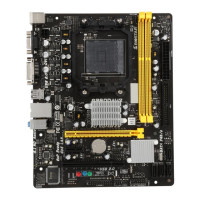What to do if Biostar Motherboard has no power?
- PpwhitakerAug 4, 2025
First, ensure the power cable is securely plugged in. If the issue persists, try replacing the power cable. If neither of these steps works, the problem may be more complex.

What to do if Biostar Motherboard has no power?
First, ensure the power cable is securely plugged in. If the issue persists, try replacing the power cable. If neither of these steps works, the problem may be more complex.
What to do if Biostar Motherboard system doesn't boot from hard disk?
Check the cable connecting the hard disk to the disk controller board, ensuring both ends are securely plugged in. Also, verify the drive type in the standard CMOS setup. It's important to back up your hard drive regularly, as they can fail at any time.
What to do if Biostar Motherboard shows invalid configuration?
Review your system's equipment and ensure that the correct information is entered in the setup.
What to do if Biostar A960D+V2 Motherboard CPU is overheated?
Remove the power cord from the power supply for a few seconds. Wait, then plug the power cord back in and boot up the system. If the issue persists, clear the CMOS data, wait a few seconds, and power on the system again.
How to fix Biostar A960D+V2 Motherboard when it cannot boot after installing a second hard drive?
Set the master/slave jumpers correctly. Then, run the SETUP program and select the correct drive types.
| Brand | Biostar |
|---|---|
| Model | A960D+V2 |
| Category | Motherboard |
| Language | English |
Provides essential instructions and precautions before installing the motherboard.
Lists all the components included in the motherboard package for verification.
Details the specifications and components of the motherboard.
Identifies and describes the connectors located on the motherboard's rear panel.
Provides a visual diagram showing the location of key motherboard components and connectors.
Step-by-step guide on how to properly install the CPU onto the motherboard socket.
Instructions for mounting the heatsink and fan assembly onto the CPU.
Explains the function and pin assignments of CPU and system fan headers.
Detailed steps for installing RAM modules into the motherboard's DIMM slots.
Details various connectors and slots on the motherboard, including SATA, IDE, and expansion slots.
Details the 24-pin and 4-pin ATX power connectors for the motherboard and CPU.
Describes the specifications for PCI Express and standard PCI slots.
Step-by-step guide for installing expansion cards into PCI/PCIe slots.
Illustrates how to correctly set up jumpers on the motherboard.
Provides detailed settings for specific jumpers like the Clear CMOS jumper.
Guide on installing drivers, software, and manuals from the provided DVD.
Instructions for installing motherboard software and utilities like eHOT Line.
Utility for updating and managing the motherboard's BIOS settings.
Utility for updating BIOS via USB pen drive or floppy disk.
Addresses common system issues and provides solutions.
Addresses common system issues like no power, inoperative system, and boot failures.
Explains CPU overheating issues and protective shutdown mechanisms.
Details different RAID levels (0, 1, 10) and their features, benefits, and drawbacks.
